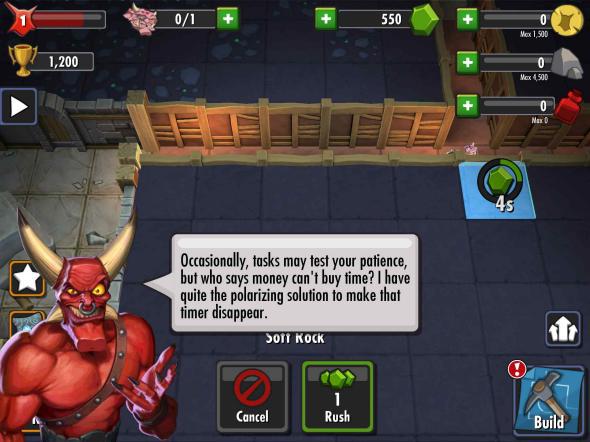If you asked gamers to imagine the corporate headquarters of Electronic Arts, the biggest game publisher in the industry, they’ll probably envision a cast of shadowy characters arrayed around a long table in a subterranean chamber, cackling as they find new ways to grow their treasure hoards by nickel-and-diming hapless gamers. Perhaps this image is unfair, but the publisher’s recent resurrection of the beloved Dungeon Keeper after a 15-year hiatus has not challenged it.
The original was a 1997 strategy-simulation game that put players in control of a dungeon populated by monsters, such as goblins and trolls, and pitted them against other dungeons or goodly creatures, like knights and elves. It was a fantastically creative game with a charmingly witty tone. Although it gained a cult following and inspired games like Minecraft, it nevertheless ended up sputtering out after a single sequel in 1999.
That is, until E.A. released Dungeon Keeper for iOS and Android last month. “So you’ve finally returned,” the narrator says when players first open the app, as if to reward veterans for years of patience. Sadly, they’re returning to dungeons quite unlike the dungeons of yore. In these dungeons, everything takes a lot longer than it used to. Recruiting a new creature takes a couple minutes. Building a new room takes five minutes. Some tiny blocks take an entire day to clear—literally, the countdown timer on them says “1D,” then “23 hr 59 m.” As a result, the game tends to grind to a halt after a few minutes of play. There’s nothing to do at a certain point but just wait.
Unless, of course, you pay for “gems.” Sure, they can be acquired in small amounts through in-game missions, but these missions themselves can cost more gems than they’re worth. To a player of the original Dungeon Keeper, this sucks, and the game appears to know it. Gems, the game’s narrator explains, are a “polarizing solution” that is “loved by some, feared by others” and “tolerated by the rest.” That’s where the self-awareness ends. After that, players are bombarded with constant opportunities to buy and spend gems. “There is no time to be stingy!” the narrator proclaims.
Yes, we get it—E.A. wants our money. Fans of the franchise are reasonably outraged by this. The game has netted a measly three stars on App Store after thousands of reviews, with most comments complaining about the gem system, and a sad 45 out of 100 on MetaCritic. “The tragedy of Dungeon Keeper is that every so often, it shows glimpses of what makes it great,” wrote Jaz Rignall in USGamer:
You can see the classic game is in there somewhere: its genius, and what it could have been. But then the gates slam shut, as though the Dungeon Keeper himself is kept in a larger meta-dungeon, whose bean-counting overlord tells you to come back later, or maybe even tomorrow. Or pay up.
The designer of the original Dungeon Keeper was predictably unimpressed. “I just want to make a dungeon,” he told BBC. “I don’t want to schedule it on my alarm clock for six days to come back for a block to be chipped.”
The developers made another crucial misstep in the Android version, in which a screen invites players to rate the game but first asks them if they would give it five stars or fewer than five stars. Users were redirected to the Android store to actually rate the game only if they said they would give it five stars. It was a simple ploy to filter out negative reviews.
Now, the developers are defending themselves. “It’s important to emphasize that we designed a game that is built around the typical mobile play patterns,” the game’s senior developer told TabTimes. “This means Dungeon Keeper is meant to be played on the go multiple times a day with a few minutes here or there. This way of playing allows fans to naturally progress as a free player.”
That’s fair—but it also illustrates the problem that is this new Dungeon Keeper. As a free-to-play game, it’s actually not that bad. The problem is that instead of E.A. thinking of something totally original for the free-to-play model, it took a beloved game from the ‘90s and mutilated it to fit that model. On top of that, E.A. gave the product the exact same name as the original instead of flagging it as a spin-off with something like Dungeon Keeper: Tap It. To fans of the original, it’s as if Nintendo made a mobile Super Mario Bros. and required players to pay to jump.
